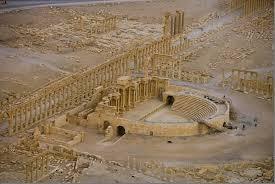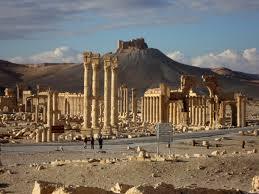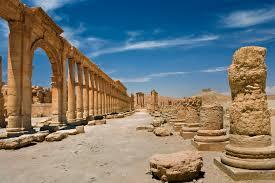We must save the ancient city of Palmyra from ISIL at whatever cost!
 Palmyra in Syria cant not be allowed to become another victim of ISIL. An oasis in the Syrian desert, north-east of Damascus, Palmyra contains the monumental ruins of a great city that was one of the most important cultural centres of the ancient world. From the 1st to the 2nd century, the art and architecture of Palmyra, standing at the crossroads of several civilizations, married Graeco-Roman techniques with local traditions and Persian influences.
Palmyra in Syria cant not be allowed to become another victim of ISIL. An oasis in the Syrian desert, north-east of Damascus, Palmyra contains the monumental ruins of a great city that was one of the most important cultural centres of the ancient world. From the 1st to the 2nd century, the art and architecture of Palmyra, standing at the crossroads of several civilizations, married Graeco-Roman techniques with local traditions and Persian influences.
The history of these well preserved ruins is extraordinary rich and is part of the history of humanity. Palmyra’s wealth allowed the construction of many monumental projects. By the third century, Palmyra was turned into a prosperous metropolis, with a strong army capable of defeating the Sassanid Empire in 260. Following the victory, Palmyra’s chief Odaenathus was proclaimed king but was assassinated in 267. He was succeeded by his minor sons, under the regency of queen Zenobia, who started invading the Roman eastern provinces in 270. The rebellion was masked by a nominal subordination to Rome. However, the situation escalated and the Palmyrene rulers adopted the imperial titles in 271. Roman emperor Aurelian defeated Palmyra in 272, and destroyed it in 273 after a failed second rebellion. Palmyra became a minor city under the rule of the Byzantine, Rashiduns, Ummayads, Abbasids, Mamluks, and their vassals. After being destroyed by the Timurids in 1400, Palmyra remained a small village under the rule of the Ottomans until 1918, then the Syrian kingdom, followed by the French Mandate. In 1929 the French started evacuating the villagers into the newly built village of Tadmur. The evacuation was completed in 1932 and the site became abandoned and available for excavations.
The Palmyrenes were mainly a mix of Arameans, Amorites and Arabs, in addition to Jewish and Greek minorities. The society was tribal and the inhabitants spoke their own dialect of Aramaic, in addition to Greek. Both of the languages were replaced by Arabic following the Arab conquest in 634. Palmyra’s local culture was influenced by the Greco-Roman and Persian cultures, which produced a distinctive art and architecture. The city’s inhabitants worshiped local deities, in addition to Mesopotamiam and Arab gods. They later converted to Christianity in the fourth century, followed by Islam in the second half of the first millennium.
The Palmyrene political organization was based on the Greek city-state model. It was governed by a senate responsible for both the public works and the military. After gaining the status of a Colonia in the third century, Palmyra incorporated Roman institutions to its system before adopting a monarchical system in 260. Palmyra gained its wealth from caravan trade. The Palmyrenes were renowned merchants who established colonies along the Silk Road, and conducted their operations all around the Roman empire.
ISIL has already destroyed the ancient Assyrian city of Nimrod and have also have bulldozed the world heritage city of Hatra and at whatever cost, must not be allowed to commit another crime of CULTURAL GENOCIDE. The United Nations and all the governments of the world including the governments of Muslim countries must work together and fast, to prevent the destruction of this unique and wonderful world heritage.
How would the Islamic world react if a crazy sect of fanatic Christian fundamentalist went around destroying World heritage Islamic sights such as the Masjed-e-Jamé of Isfahan in Iran or the Taj Mahal in Agra to name a couple?
But this barbarian assasins that are also responsible for the worst crimes of Cultural genocide do not only destroy non Muslim sights.
In 2014, media reported destructions of multiple, chiefly Shiite, mosques and shrines throughout Iraq. Among them were Al-Qubba Husseiniya Mosque in Mosul, Jawad Husseiniya Mosque and Saad bin Aqeel Husseiniya Shrine in Tal Affar, Sunni Ahmed al-Rifai Shrine and tomb in Mahlabiya District and the so-called Tomb of the Girl (Qabr al-Bint) in Mosul. The Tomb of the Girl, reputed to honour a girl who died of a broken heart, was actually believed to be the tomb of medieval scholar Ali ibn al-Athir . In June 2014, ISIL bulldozed the shrine of Fathi al Ka’en. On September 24, 2014, the Al-Arba’een Mosque in Tikrit, containing forty tombs from the Umar era, was blown up. On February 26, 2015 ISIL blew up the 12th century Khudr Mosque in central Mosul.
In Mosul, ISIL also targeted several tombs with shrines built over them. In July 2014, ISIL destroyed one of the tombs of prophet Daniel by implanted explosives. In the same year, on July 24, the tomb and mosque of prophet Jonah was destroyed with explosives. On July 27, ISIL destroyed the tomb of Prophet Jirjis. On July 25, 2014, the 13th-century shrine of Iman Awn al-Din in Mosul, one of the few structures to have survived the 13th-century Mongol invasion, was also destroyed by these monsters. All destructions were carried out mainly with explosive devices, in some cases with bulldozers. In March 2015, ISIL reportedly bulldozed to the ground the Hamou al-Qadu Mosque in Mosul, dating back to 1880.
ISIL also destroyed beautiful Sufi shrines near Tripoli in Lybia, in March 2015. The shrines were destroyed by sledgehammers and bulldozers.
So, in my view, it is clear what needs to be done. The whole world must unite to put an end to these acts of barbarism. Our common ancient cultural heritage must be saved at ALL costs. Palmyra MUST be saved and these bunch of criminal thugs MUST me made to pay for the destruction of all these historical sights that are now lost forever.





